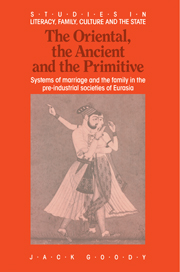 The Oriental, the Ancient and the Primitive
The Oriental, the Ancient and the Primitive Book contents
- Frontmatter
- Contents
- List of illustrations
- List of tables
- Preface
- 1 The nature of the enterprise
- PART I CHINA
- 2 The incorporation of women: marriage transactions and the continuity of the ‘house’
- 3 The lineage and the conjugal fund
- 4 Differentiation, hierarchical and regional
- 5 Land, polyandry and celibacy in Tibet
- PART II INDIA
- PART III THE NEAR EAST
- PART IV GREECE AND ROME, YESTERDAY AND TODAY
- Notes
- References
- Index
2 - The incorporation of women: marriage transactions and the continuity of the ‘house’
Published online by Cambridge University Press: 09 January 2010
- Frontmatter
- Contents
- List of illustrations
- List of tables
- Preface
- 1 The nature of the enterprise
- PART I CHINA
- 2 The incorporation of women: marriage transactions and the continuity of the ‘house’
- 3 The lineage and the conjugal fund
- 4 Differentiation, hierarchical and regional
- 5 Land, polyandry and celibacy in Tibet
- PART II INDIA
- PART III THE NEAR EAST
- PART IV GREECE AND ROME, YESTERDAY AND TODAY
- Notes
- References
- Index
Summary
Earlier work on China by anthropologists placed a great deal of emphasis on the clan, the lineage and extended family, together with forms of preferential marriage. Part of this concern was initially derived from nineteenth-century preoccupations about evolutionary trends and from comparative analysis that used elementary concepts on a global scale. The outcomes were then applied as if the institutions they referred to operated similarly in Africa and in Australia as in China. Lévi-Strauss (1949) included China, as he did Burma, in his formidable analysis of the elementary systems of kinship, while Freedman, whose two studies of the Chinese lineage (1958; 1966) were pathbreaking in a variety of ways, drew deliberate comparisons with African systems, adapting the insights developed there to the complex state society of China. Like African lineages, those of the East (in China and India) were exogamous, whereas no such prohibition existed in the Near East and Mediterranean, even where such lineages were to be found (in Islam, ancient Israel and possibly the classical world). Up to a limited point the results were profitable. But they would have been yet greater had these authors also looked more closely at the structure of domestic groups. By this phrase I mean that constellation of productive and reproductive groupings that centre around the domus, that is the ‘house’ as an association of people, property and custom, which is not confined to those living together at one particular moment but comprises a number of partly overlapping units, the family (the conjugal unit), the household (the consumption unit), the enterprise, often focusing on the farm (the production unit), and the dwelling group.
- Type
- Chapter
- Information
- The Oriental, the Ancient and the PrimitiveSystems of Marriage and the Family in the Pre-Industrial Societies of Eurasia, pp. 21 - 51Publisher: Cambridge University PressPrint publication year: 1990


